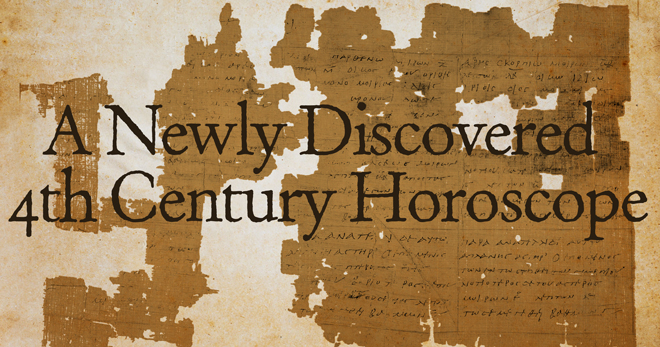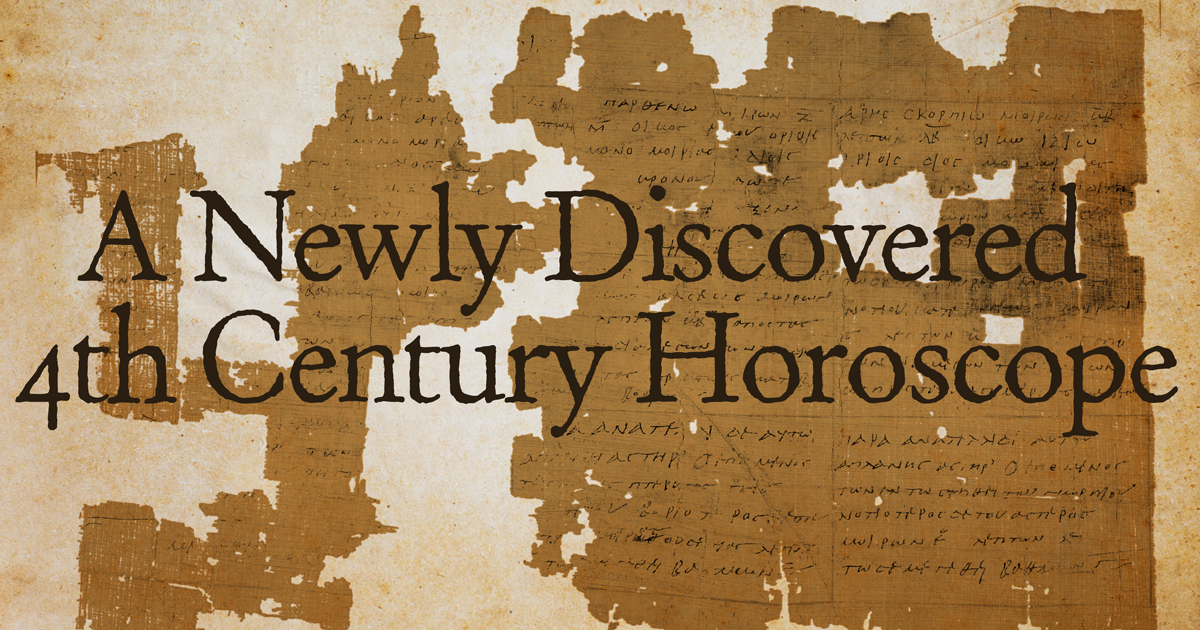
Episode 129 of the podcast features an interview with Dorian Greenbaum about the recent discovery of a new horoscope from Egypt that dates to the 4th century CE.
In September of 2017 Dorian Greenbaum and Alexander Jones published a paper on the discovery through the Institute for the Study of the Ancient World, titled P.Berl. 9825: An elaborate horoscope for 319 CE and its significance for Greek astronomical and astrological practice.
The chart contains a number of interesting and unique features, such as zodiacal subdivisions and lots, which we discuss during the course of the interview.
Below you will find the show notes, which contain an outline of some of the points that we touched on in the discussion, followed by links to download or stream the recording of this episode of the podcast at the bottom of the page.
Show Notes
- Introducing Dorian and talking a bit about her background.
- Received her PhD from the Warburg Institute in 2009.
- The Daimon in Hellenistic Astrology: Origins and Influence
- Expanded version published by Brill in 2015: The Daimon in Hellenistic Astrology: Origins and Influence
- The Daimon in Hellenistic Astrology: Origins and Influence
- Received her PhD from the Warburg Institute in 2009.
- New discovery of a papyrus birth chart that dates to the 4th century CE.
- The chart is unique for several reasons.
- Is an elaborate or “deluxe” horoscope.
- Positions to the degree and minute, plus zodiacal subdivisions.
- Only about 26 deluxe horoscopes survive.
- Contains the seven Hermetic lots mentioned by Paulus Alexandrinus.
- Also calculates the Master of the Nativity.
- Paper is titled “P.Berl. 9825: An elaborate horoscope for 319 CE and its significance for Greek astronomical and astrological practice”
- Published September 2017 by the Institute for the Study of the Ancient World.
- Co-authored with Alexander Jones, who discovered the papyrus in the Berlin archives.
- Background on other surviving horoscopes from antiquity.
- Around 350 Greek horoscopes survive from antiquity.
- They say there are 446 extant horoscopic texts total from antiquity.
- Several collections of ancient horoscopes have been published.
- Around 350 Greek horoscopes survive from antiquity.
- About the Greco-Roman “horoscopes”.
- Horoscope as a generic term for “chart” (thema) here.
- Distinction between literary charts versus standalone (usually called ‘documentary’) charts.
- Distinction between standard charts versus deluxe horoscopes.
- The lack of delineation potentially being due to verbal interpretations.
- Horoscope boards.
- Most of the horoscopes are fragments of papyrus with calculated placements.
- Usually thought the placements recreated on horoscope board for consultation
- Rediscovering the chart.
- Where and how was the chart found?
- What methods were used to date it?
- Are the positions in the chart tropical or sidereal?
- The process of putting together the missing pieces.
- Lots (so-called “Arabic Parts”).
- Not a ton of charts with lots survive.
- They are the second most used point outside of the planets in surviving horoscopes.
- Most just have the Lot of Fortune, then some the Lot of Spirit, and then a handful of others.
- Dorian prefers to refer to it as the Lot of Daimon.
- Discussion about the concept of the daimon.
- This is the earliest and only standalone chart to contain so many lots.
- This chart is unique in that it has all seven lots mentioned by Paulus.
- Sometimes referred to as the Hermetic lots
- Olympiodorus and a scholion say the Panaretus was by Hermes
- Paulus is/was our earliest extant source for that full set of lots.
- Although the Panaretus obviously would have been earlier.
- Paulus wrote his Introduction in 378 CE.
- Earlier tradition used alternative calculations for Eros and Necessity.
- Present in Dorotheus, Valens, and Firmicus.
- Seems to imply that the Paulus versions were introduced later?
- This is the first surviving documentary horoscope that contains all of the Hermetic lots.
- It is a night chart, and it does reverse the calculation of Fortune accordingly
- The rest of the Lot calculations are also reversed.
- Use of zodiacal subdivisions.
- Discussion about the stated position of the Midheaven and whether it indicates the use of equal or quadrant houses.
- Use of the Master of the Nativity.
- Possible connection with Paulus.
- Parting thoughts.
Transcript
A full transcript of this episode is available: Episode 129 transcript
Listen to This Episode
You can either play this episode of the podcast directly from the website or download it as an MP3 to your computer by using the buttons below:
Podcast: Play in new window | Download (Duration: 2:01:37 — 56.0MB)
